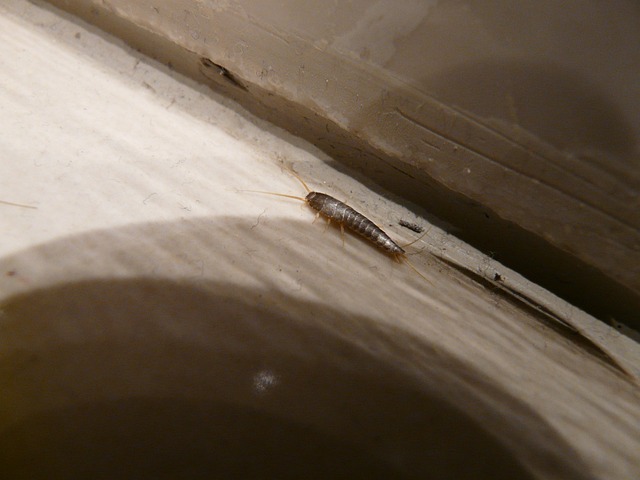Silverfish infestations require a multi-pronged approach focusing on understanding their behavior, sealing entry points, reducing moisture, and eliminating food sources. For residential areas, this includes identifying cracks, maintaining cleanliness, and using airtight containers. Commercial spaces need strategic IPM integrating inspections, sealing, cleaning, and eco-friendly solutions alongside professional expertise. Preventative measures like regular cleaning, sealing, and monitoring are vital for both settings to avoid and manage silverfish infestations effectively.
“Unraveling the secrets of effective silverfish control is essential for maintaining pest-free residential and commercial environments. This comprehensive guide delves into tailored strategies to combat these elusive creatures, known as silverfish. Understanding their behavior and habitat is key to successful removal. We explore distinct approaches for homes and businesses, offering practical tips for prevention and long-term solutions. Discover how to break free from the cycle of silverfish infestations with our expert advice on silverfish infestation removal.”
Understanding Silverfish Infestations: Behavior and Habitat
Silverfish infestations can be a persistent and unsettling problem for both residential and commercial spaces. Understanding their behavior and habitat is crucial in implementing effective silverfish infestation removal strategies. Silverfish, also known as firebrats, are nocturnal creatures that thrive in humid environments with access to food sources like starchy materials, carbohydrates, and cellulose. They are drawn to dark, tight spaces, making their habitats vary from cracks and crevices in walls to behind appliances and under floorboards.
Their swift reproduction rates can quickly transform a minor infestation into a major issue. To combat silverfish infestations, it’s essential to address their preferred environments. This includes sealing entry points, improving ventilation, reducing moisture levels, and removing potential food sources. Regular inspections and prompt action are key to managing these elusive pests effectively.
Residential Silverfish Control Strategies
Residential Silverfish Control begins with identifying and addressing entry points, as these tiny creatures are adept at slipping into homes through cracks, gaps around pipes and windows, or even small openings in walls. Sealing these areas with caulk or appropriate materials is a crucial first step in silverfish infestation removal. Regular cleaning and maintenance are also essential; wiping down surfaces, vacuuming floors, and regularly washing bed linens can help deter silverfish.
Additionally, keeping spaces dry is vital to preventing silverfish infestations. Using dehumidifiers in damp areas like basements or bathrooms can reduce moisture levels, making these spaces less appealing to silverfish. Store seasonal items, especially fabrics, in airtight containers to avoid attracting them. Implementing these strategies can significantly reduce the risk of a residential silverfish infestation and, if present, facilitate effective removal.
Commercial Spaces: A Different Approach to Silverfish Management
Commercial spaces, such as offices, retail stores, and hotels, present unique challenges when it comes to silverfish control. Unlike residential settings, these environments often involve larger areas with diverse materials, complex supply chains, and higher foot traffic. Therefore, a more strategic and comprehensive approach is necessary for effective silverfish infestation removal.
In commercial spaces, it’s crucial to implement integrated pest management (IPM) strategies that go beyond mere chemical treatments. This involves meticulous inspection and monitoring, identifying and sealing entry points, implementing strict cleaning protocols, and utilizing non-toxic, eco-friendly repellents. Regular maintenance, proper waste management, and collaboration with professionals specializing in commercial silverfish control are essential to prevent and manage infestations efficiently.
Preventative Measures and Long-Term Solutions for Silverfish Control
Preventative measures are key in managing and avoiding a silverfish infestation. Regular cleaning and maintenance can significantly reduce their presence. Keeping spaces clean, particularly in areas prone to moisture build-up like kitchens and bathrooms, is essential. Sealing entry points such as cracks and gaps around pipes, windows, and doors helps prevent these insects from finding their way inside. Using pest control products specifically designed for silverfish or employing natural deterrents like diatomaceous earth can also act as effective preventative tools.
For long-term solutions, addressing the root causes of silverfish attraction is crucial. This includes reducing moisture levels in homes and buildings, improving ventilation, and maintaining a clean, clutter-free environment. Regular inspections are beneficial to identify and treat any early signs of an infestation. Professional pest control services that offer tailored treatments and ongoing monitoring can provide effective long-term solutions for both residential and commercial spaces, ensuring silverfish infestation removal and preventing future occurrences.
Tailored silverfish control strategies are essential for effective silverfish infestation removal in both residential and commercial spaces. Understanding these creatures’ unique behavior and habitat is key to success. For homes, a combination of residential control methods, including thorough cleaning, sealing entry points, and targeted treatments, offers long-lasting solutions. In contrast, commercial spaces require a different approach, focusing on professional inspections, integrated pest management (IPM) strategies, and proactive preventative measures due to the larger scale and specific environmental conditions. By implementing these tailored strategies, it’s possible to prevent and manage silverfish infestations effectively, ensuring a pest-free environment for all.
